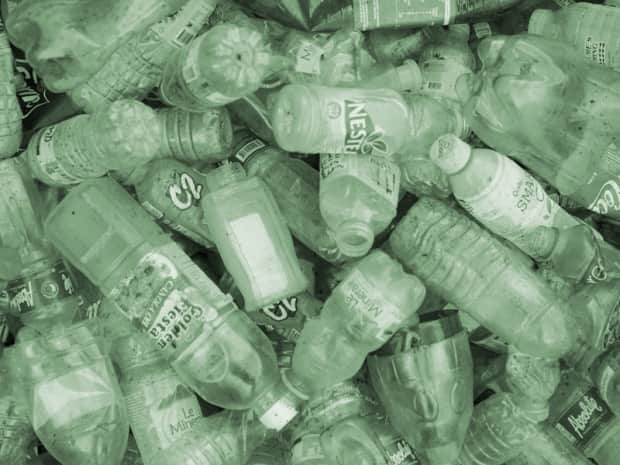
Is Plastic Really Getting Recycled In the U.S.?
Recyclable plastic packaging is a myth; here’s why plastic recycling doesn’t work.
Read More

Last Updated: August 12, 2022
Plastic pollution in the ocean can lead to microplastics and nanoplastics entering our foodstreams and water sources. Here’s what you need to know.
Humans eat the equivalent of a Lego brick of plastic per week. You’re probably wondering how that’s possible — after all, you don’t keep a plastic shaker next to your salt and pepper, and you don’t take a plastic supplement every morning with your daily vitamin.
Enter microplastics. Microplastics have garnered a lot of attention recently, and for good reason. We eat them, we inhale them, and we find them in the deepest part of the ocean and near the top of Mount Everest — but what are microplastics, and how are they affecting us?
Microplastic pollution is omnipresent, but there are steps you can take to lessen your exposure. Here, we take a closer look at these tiny plastic particles and zoom in on how they affect our health and the environment. Plus, learn five ways you can avoid microplastics as you go about your day.
Microplastics are tiny pieces of plastic debris less than five millimeters long. That’s around the size of a pencil eraser, but microplastics can break down to particles smaller than the width of a strand of hair. They come from various sources like fibers from nylon and polyester fabrics, glitter, and microbeads in face scrubs. Microplastics can even “shed” off larger plastic products like plastic bottles and bags. Microplastic particles are so small that once they’re in the environment, we can’t get them out — and that’s where the trouble begins.
When microplastics are small enough, they easily become airborne. As a result, it’s estimated that we inhale and eat around 74,000 to 114,000 particles of microplastics per year. And we don’t just excrete the microplastics we inadvertently consume — they travel to other places in our bodies, too. Microplastics have been found in our lungs, in our blood, and even in human placentas.
Every year, around 14 million tons of plastic enter the ocean through littering, water runoff, and wind. Here’s the catch: Plastic doesn’t dissolve in water — instead, it floats around and wreaks havoc on ocean ecology and marine life. Chlorinated plastics and those that contain additives like BPA and phthalates leach harmful chemicals into the water that could cause hormonal disruption, inflammation, altered gene expression, and even behavior changes in fish.
Microplastic doesn’t stop there. Freshwater fish absorb microplastics through their gills, while marine animals often mistake plastic for food. Similarly to humans, fish don’t poop out all the microplastics they consume. Studies done on seven species of fish in the Great Lakes found that 74 percent of filets — aka the part we eat — contained microplastics. When we eat the fish, we eat the microplastics present in them.
Before we get into micrplastics found in foods, let’s talk about how microplastics wind up in soil and water. When microplastics are washed down the sink — either from beauty products or from synthetic fibers in your laundry — they find their way into wastewater, which is commonly used to irrigate crops. Chemicals from plastic litter can also seep into the ground and contaminate the soil and groundwater.
Because of soil and water contamination, microplastics have been discovered in salt, sugar, beer, and plant life. A study found plastic particles in carrots, lettuce, apples, and pears, with apples coming in at a whopping 195,500 microplastic particles per gram.
How microplastics affect human health is a relatively new area of study, and there isn’t enough evidence yet to definitively say whether or not microplastics are harmful to us. What scientists do know is that there’s a risk of toxicity.
Studies found allergic reactions, cell damage, and cell death in tests done on lab mice who consumed the same relative levels of microplastics that humans ingest. When you consider that plastics often contain additives and toxic chemicals that can cause endocrine disruption, infertility, and cancer, it isn’t so surprising that eating and inhaling plastic has the potential for less-than-appetizing effects.
It’s pretty hard to avoid microplastics entirely, but you can lessen your exposure while reducing how many microplastics you put into the world. Here are five easy ways to avoid microplastics, plus a few “extra credit” tasks if you’re feeling ambitious.
If you’ve got the space (and the climate), air dry your clothes when possible. Using a dryer creates friction between fibers, which releases microplastics from synthetic fabrics. You can also reduce microplastic shedding on laundry day by investing in a GUPPYFRIEND bag, which is designed to trap the problematic fibers.
Dryer sheets are another sneaky culprit of microplastic pollution, since they’re often made from polyester — a common plastic used in the textile industry. Swap your dryer sheets for wool dryer balls instead. They work just as effectively to reduce static and soften your clothes, all without shedding microplastics onto your favorite pair of jeans.
Extra credit: Choose natural fibers when you can. Microplastic fibers make up 35 percent of all the plastic particles in the ocean, and each time you wash synthetic fabrics like nylon, polyester, microfiber cloths, and Lycra, around 9 million microplastics swarm wastewater treatment plants. Because cotton, linen, and wool are natural fibers that break down in the environment, they don’t contribute to the microplastic plague.
Not only do plastic containers shed plastic particles that could end up in our food, they also contain chemicals that leach into your leftovers when you use the microwave. Upgrade your lunchbox with glass tupperware as an eco-friendly and microwavable alternative to plastic.
Extra credit: Go the extra mile and reduce plastic in your pantry, too. Replacing plastic containers with glass jars and stainless steel containers helps cut down on your overall plastic consumption while making it that much easier to avoid potential microplastic contamination in your food.
Bottled water is one of the largest contributors to microplastic ingestion, coming in at 100 microplastics per liter — and it contains 50 percent more microplastics than tap water. Ditch the single-use plastic bottles, and opt for a stainless steel water bottle instead.
Extra credit: Outfit your sink with a water filter. While tap water has fewer microplastics than bottled water, people still consume around 4,000 plastic particles from tap water every year. Because microplastics are 5 millimeters or smaller, a water filter with a pore size of less than 0.1 micrometers should be effective at removing microplastics.
Put a dent in your plastic consumption with reusable alternatives to single-use products. Easy swaps like reusable food wrap instead of plastic wrap are real game-changers when it comes to cutting down on microplastics in your home. You can also check out our reusable alternatives to wishcycled items for ideas on how to replace items you wish you could recycle, but can’t.
Extra credit: Take the next step, and go zero waste. It might sound intimidating to cut out all the plastic from your home, but we’ve got six quick tips that make going zero waste a breeze.
Plastic microbeads are a major contributor to plastic pollution in our oceans and soil. These tiny balls of plastic are marketed as “exfoliating beads” in face and body washes, but they pollute the environment when they’re washed down the drain. Choose personal care products that use natural exfoliators instead.
Extra credit: Switch to no plastic waste personal care with products from brands like Peach. This plant-based line of waterless personal care products includes face wash, shampoo, conditioner, face soaps, and deodorant — all in plastic-free packaging.
From natural household to personal care, everything at Grove is healthier for you and the planet — and works! We recommend monthly shipments and product refills that you can edit or move at any time. No monthly fees or commitments required.

Recyclable plastic packaging is a myth; here’s why plastic recycling doesn’t work.
Silicone is in everything from baby bottles to cookware. But isn’t it just plastic? And don’t we hate plastic now? We’ve got your expert answers here.

Take out the trash in your kiddo's routine, and teach them how to reduce waste and make environmentally friendly choices at home and on the go.

Following along for detailed instructions on how to recycle and dispose of your packaging responsibly from the Sustainability team at Grove.